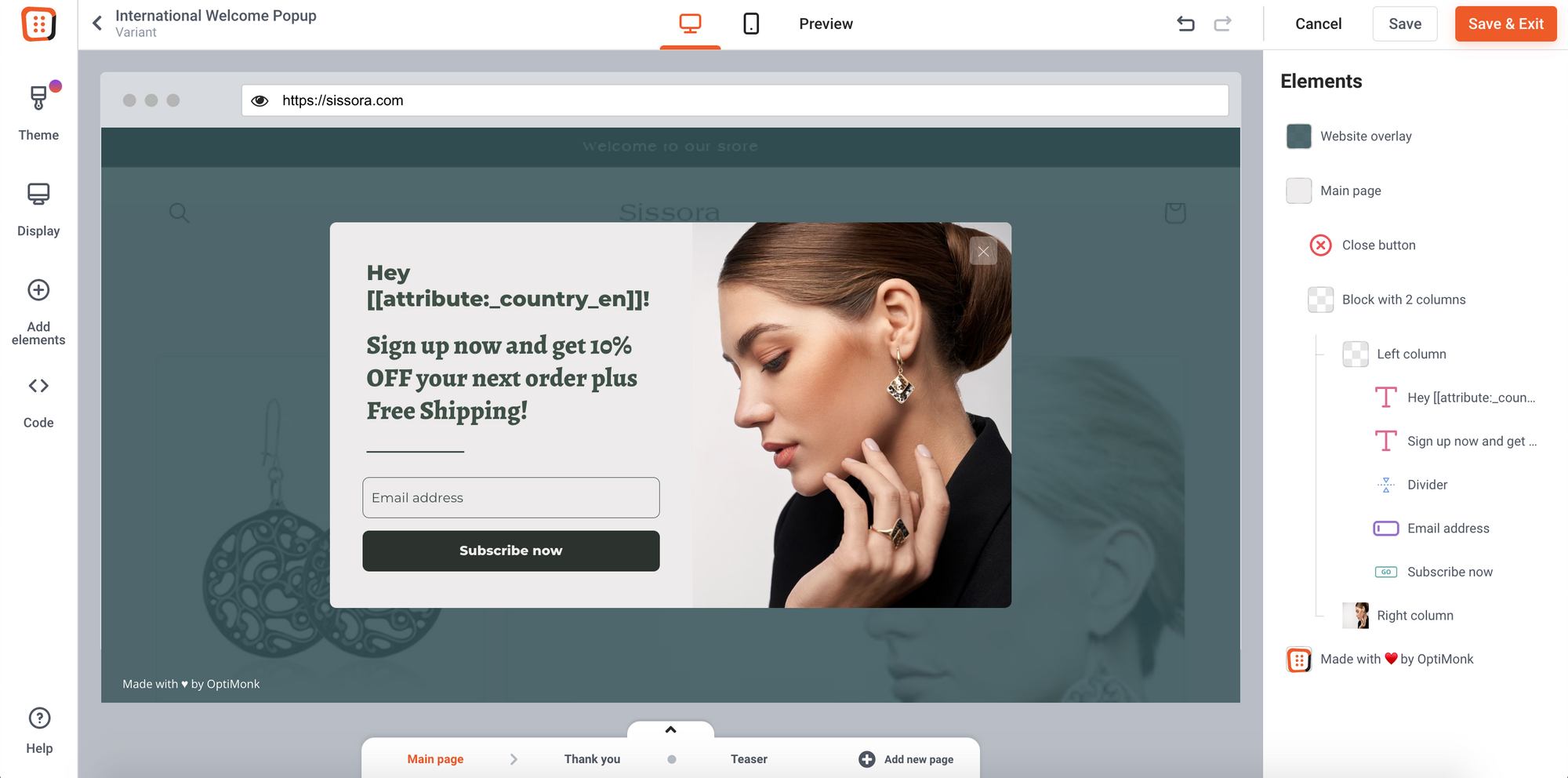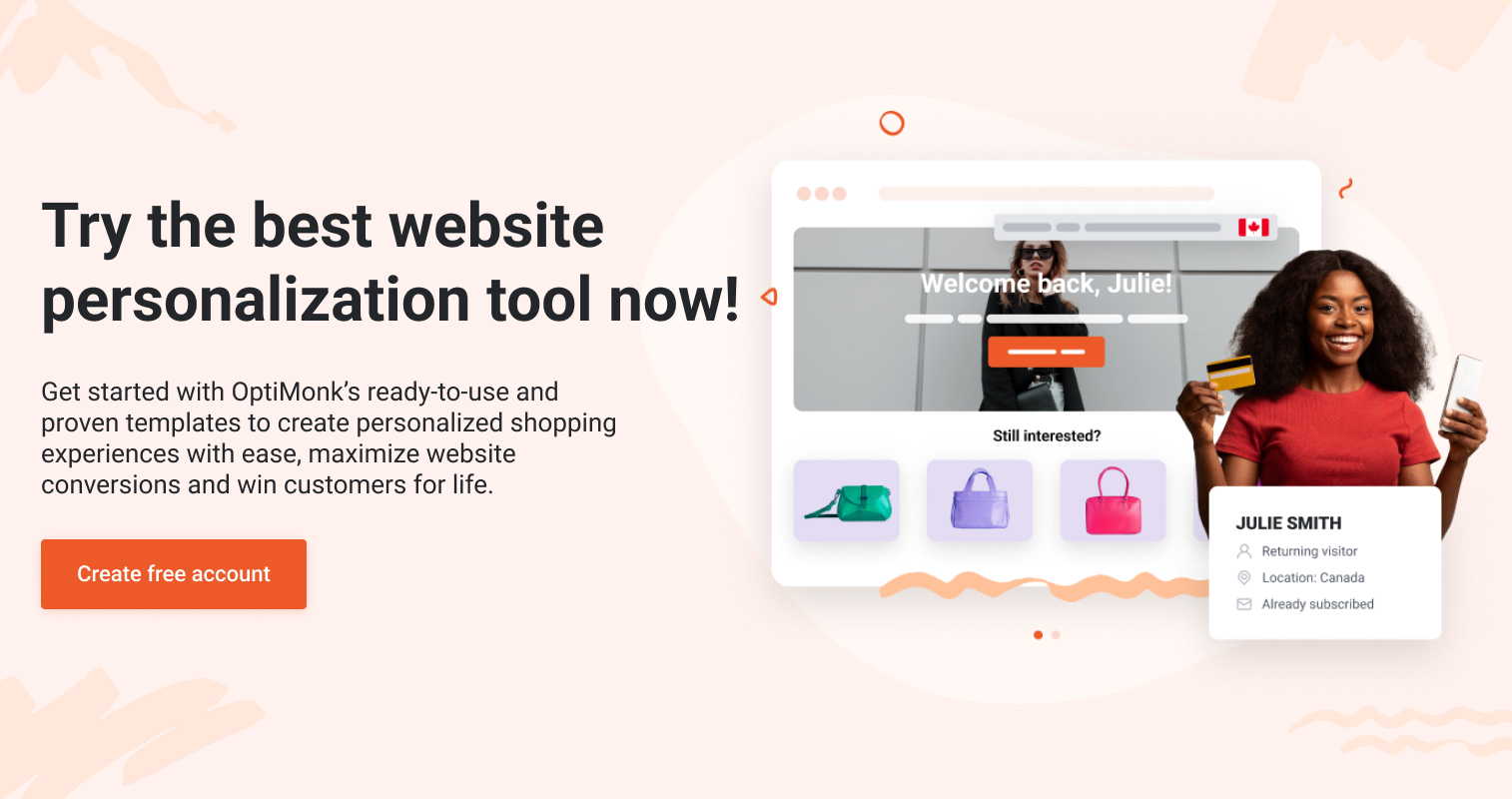- Blog
- 5 Website Personalization Best Practices to Captivate Your Visitors
5 Website Personalization Best Practices to Captivate Your Visitors
-
Barbara Bartucz
- Personalization
- 6 min read
Table of Contents
Personalization is a common part of our online lives, and ecommerce customers have come to expect it. What about you? When you order food, buy a gift for a loved one, or open Netflix, don’t you appreciate personalization that makes it easier to find what you want?
The stakes are high, and competitors are doing their best to create unique personalized experiences for their visitors. Treating your visitors as individuals and personalizing your website should be among your main goals if you want to keep up with your competitors.
If you’re just starting out with website personalization, it’s a good idea to study best practices used by industry leaders. And that’s exactly what we’re doing in this article.
Let’s get started!
What is website personalization?
Website personalization means creating a unique, tailored customer journey and user experience by using customer data to learn about the wants and needs of each individual.
Based on demographic data, behavioral data, and contextual data, marketers create personalized content for different audience segments. This ensures that all website visitors see relevant information, providing a more engaging customer journey for everyone.
Benefits of web personalization
Research shows that 74% of customers feel frustrated when browsing a non-personalized website. Not only will customers appreciate your efforts at personalizing their experience, you’ll also see concrete, quantifiable benefits, like:
1. Higher conversion rates
When you provide a tailored experience for your visitors using website personalization, they’ll be more eager to follow your conversion path. These higher conversion rates lead to more sales and more revenue.
Obvi, a DTC company that sells supplements, boosted their conversion rate during Black Friday by almost 25% with the help of website personalization.
Christopher Cloos, a high-end eyewear brand, increased their conversion rate by close to 40%. That’s how powerful website personalization is.
2. A better understanding of your customers
Website personalization involves using a variety of data points to better understand your customers. This information can help you come up with website personalization ideas, but it can also help you in several other ways (like in new product design).
3. Increased time on site
A personalized web experience makes your content more captivating for your online visitors. After all, it’s relevant content that they’re really interested in. This means that your customers will likely spend more time on your site.
4. More customer loyalty
Website personalization also leads to more customer loyalty. If a person feels that an ecommerce business is able to anticipate their needs, they’ll be more enthusiastic about shopping with that brand. They’re much more likely to become loyal customers.
Tons of research shows that customers prefer to shop with brands that take care of them (and their needs).
3 steps of website personalization
Now that we’ve gone over the benefits you can expect as a result of your personalization efforts, let’s take a look at how you can actually implement a personalization strategy.
The website personalization process has 3 main steps.
- Audience discovery: At this stage, you’ll split your target audience into smaller segments (also called buyer personas) that have something in common.
- Message creation: Next, you’ll need to create messages for each of your buyer personas or segments.
- Evaluation: After implementing your personalized messaging, you need to measure and analyze your results. Knowing what’s working and what’s not will help you decide on the next steps.
Check out this video for a more in-depth guide to web personalization:
Types of website personalization
There are two distinct ways to deliver personalized content to each individual, and both types of website personalization have strengths and weaknesses.
Let’s take a look.
1. Embedded content
Using embedded content to personalize your website means that you change the base (native) content of your website depending on who’s viewing it.
Different audience segments will see different web pages, which can involve things like changing a headline or offering a discount to some segments but not others.
Dynamic embedded content is the least intrusive way to conduct web personalization, because online visitors won’t even notice that they’re seeing personalized content. Rather, they’ll just think they’re seeing the “normal” version of your website.
2. Overlays
Overlays allow you to display personalized content that appears “on top” of the base layer of your website. Popups and sticky bars are the most common type of overlays for dynamic website personalization.
Using overlays to create a personalized experience is more intrusive than using embedded content, since the appearance of a popup, sticky bar, or sidemessage interrupts the visitor’s browsing experience.
However, this also makes page elements like popups more noticeable than embedded content. Often, this increased visibility leads to higher conversion rates.
A powerful website personalization strategy contains both types of messages.
5 website personalization best practices
Here are some best practices that top brands are using to take their personalized campaigns to the next level.
As we go through these, notice how these brands take advantage of all the data points they can get their hands on for web personalization.
Tip #1: Use geotargeting
UK-based fashion giant ASOS uses location data extremely well. Below, you can see a custom message they display to visitors from Hungary.
They don’t display this information for no reason… there’s actually a brilliant upselling strategy associated with it. They’re encouraging their customers to spend more in order to reach their free shipping threshold.

By using OptiMonk’s Smart Tags feature, you can create hyper-personalized experiences that engage visitors and improve the customer experience. You can use any of the customer data you collect, including location data.
All you need to do is to insert the follwing Smart Tag into your message (wherever you want the country to appear): [[attribute:_country_en]].

Tip #2: Recommend your best products
As mentioned before, Christopher Cloos uses OptiMonk for their website personalization efforts.
On their shopping cart page, they have an embedded section that recommends their best products for each individual customer. This invites customers to browse further before checking out, increasing their average order value.

You can create the exact same personalized shopping experience as Christopher Cloos does using OptiMonk’s product recommendation feature and the templates below.
Tip #3: Offer gifts or free products
Obvi is a DTC brand that sells dietary supplements and vitamins online. When their visitors spend more than $75, they get a gift like a free mask. This provides a great incentive for their customers to purchase more, raising their average order value.
They even go a step further by showing customers the bundles of products they can buy for $75 or more.

OptiMonk’s web personalization software can help you create similar campaigns. You can even leverage a user’s browsing history to recommend bundles they’re likely to be interested in.
Based on a visitor’s browsing history or shopping cart, you can create personalized product recommendation campaigns. To get started, use one of the templates below:
Tip #4: Show what other people are ordering
Beauty Pie is an exclusive skincare and makeup brand.
One excellent tactic their marketing team uses is displaying what others are ordering. This is great social proof that makes their products seem desirable.

Tip #5: Offer a “perfect match”
Meow Meow Tweet creates natural personal care products, including things like face cream and deodorant.
They use a creative cross-selling tactic that they call a “perfect match.” This shows complementary products that go well together.

Our Place, a cookware ecommerce store, uses a similar tactic. The difference is that they display the complementary products on the checkout page.

How can you improve your website personalization?
Once you get your personalization efforts up and running, you should constantly be optimizing. This is the only way to ensure your personalization is working as effectively as possible.
1. Know your audience
You should always be getting to know your customer better and better. This means keeping track of all the customer data you can get your hands on.
Here are some ways of collecting data:
- Dig into your Google Analytics account
- Use heat maps and mouse-tracking software like Hotjar
- Run customer interviews
- Ask your customer support department about common issues and pain points
For more information on audience discovery, check out this video:
2. Get your timing right
Showing the right message at the right time is vital.
You want to engage visitors, not overwhelm them. That means striking the perfect balance without showing too much or too little personalized content.
You should use a combination of embedded content and overlays to avoid ruining the customer experience by flashing popups every 5 seconds.
3. Measure and optimize
For any kind of (marketing) activity, you need a way to measure it. While you’re setting your website personalization goals, always decide what numbers you’re going to measure and what your main KPIs will be.
Once you know what you’re tracking, you can run A/B tests to find out whether different versions of your messages will improve your results. OptiMonk allows you to easily run A/B tests on your web personalization!
Learn more about A/B testing by watching this 3-min video:
Key takeaways
We hope you’ve enjoyed our overview of website personalization best practices.
If you’re interested in learning more, read our Ultimate Guide for Website personalization. This will give you all the tools you need to create a meaningful user journey and move potential customers through your sales funnel!
All the website personalization best practices, tactics, and strategies we went over can be implemented using OptiMonk. If you haven’t created a free account yet, get on it today!
Migration has never been easier
We made switching a no-brainer with our free, white-glove onboarding service so you can get started in the blink of an eye.

What should you do next?
Thanks for reading till the end. Here are 4 ways we can help you grow your business:
Boost conversions with proven use cases
Explore our Use Case Library, filled with actionable personalization examples and step-by-step guides to unlock your website's full potential. Check out Use Case Library
Create a free OptiMonk account
Create a free OptiMonk account and easily get started with popups and conversion rate optimization. Get OptiMonk free
Get advice from a CRO expert
Schedule a personalized discovery call with one of our experts to explore how OptiMonk can help you grow your business. Book a demo
Join our weekly newsletter
Real CRO insights & marketing tips. No fluff. Straight to your inbox. Subscribe now
Barbara Bartucz
- Posted in
- Personalization
Partner with us
- © OptiMonk. All rights reserved!
- Terms of Use
- Privacy Policy
- Cookie Policy
Product updates: January Release 2025









